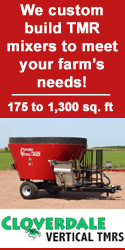 |
 |

|
|
|
Minnesota Ag News Headlines |
 |
Introducing ManureDB: A New Way to View Manure Variability and Trends
Minnesota Ag Connection - 03/06/2024
Manure is used as an organic fertilizer source on approximately 31 million United States (U.S.) acres, equating to 10% of US cultivated land the Conservation Effects Assessment Project (CEAP) II survey of practices from 2013-2016 estimates (USDA NRCS, 2022). Manure book values, approximate nutrient concentrations, are used for developing manure management plans, designing manure storages, creating best management practices for manure land application, and agricultural modeling.
They show a range of nutrient values that can be expected from typical manure storages and encourage farmers to test their manure often. However, current book values are several decades old and may not reflect current production practices. Recent laboratory data from the Midwest indicated manure nutrient data has changed compared to published Midwest Plan Service (MWPS) book values (Bohl Bormann, 2022; Lorimor et al., 2004). Different animal diets, treatments, genetics, housing, and manure storage and handling practices can impact these manure nutrient values.
Researchers at the University of Minnesota received Agriculture and Food Research Initiative (AFRI) National Institute of Food and Agriculture (NIFA) grant funding in 2020 to create a manure nutrient database called ManureDB using FAIR principles (Findable, Accessible, Interoperable, and Reusable) in collaboration with the Minnesota Supercomputing Institute.
This project partners with laboratories and universities that analyze manure for business and/or research. A project team comprised of commercial manure laboratories, livestock commodity groups, regulatory and agency staff, agriculture professionals, researchers, engineers, and alternative energy groups guides the development process.
This project highly values data privacy. A data use agreement gets signed between the participating laboratory and the University of Minnesota. Laboratories can share past manure data and annual data going forward with no customer names or addresses shared to avoid privacy concerns. Only the state or first three digits of a ZIP code are entered into the database. The ZIP codes and laboratory identities will not be included in the public-facing database. At least five samples per year from a state or region will be needed to show up in public summaries.
As one can imagine, all the laboratories report their results in many ways and producing a standardized template was a high priority. The database only requires the year the sample was analyzed but offers many other reporting options and sample notes. A manure type, animal or other amendment type, manure treatment, if agitated, bedding type, storage type, length of storage, and application method options can be selected if known.
The template offers a wide selection of analyte options from macronutrients, micronutrients, and other metals and ratios. For each analyte reported the analytical method, units reported, and wet or dry basis is selected. The project based the analytical method selections off of the recently updated Recommended Methods of Manure Analysis (Wilson et al., 2022), the AgGateway Modus Agricultural Lab Test Data Standard (AgGateway, 2023), and interviews with laboratories. A spreadsheet validation step ensures the data conforms to the template parameters prior to uploading to the database. Once uploaded, each sample is given a unique ManureDB identifier and conversion equations are used to display data in consistent units.
The public facing ManureDB database launched in summer 2023 at ManureDB.umn.edu and recently released a data download feature in January 2024. See Figure 1 for a screenshot of the homepage. New features and improvements continue to roll out.
The database interface offers data aggregation with preliminary filters and provides some overview statistics. As of February 2024, ManureDB includes >490,000 samples from 49 states, 14 laboratories, over 65 animal types, and 18 organic amendments. With other data use agreements signed and some pending, the database will continue to grow with additional datasets and annual data additions from participating laboratories. The team continues to refine and build features in ManureDB, with plans to add data visualization displays, make the website mobile-friendly, and streamline the annual data update process. Eventually a log-in feature is planned for laboratories to view their lab-specific data relative to the aggregated database. The team plans to archive data on an annual basis in the USDA National Agricultural Library’s Ag Data Commons.
Click here to read more umn.edu
Other Minnesota Headlines
|
|
 |


|
 |
|
Copyright © 2024 - Farms.com. All Rights Reserved. |
 |
|